Museum seeks sponsor for silver collection

After that date, the collection — capable of transforming the silver holdings at the Museum of Decorative Arts at Collins Barracks, Dublin, into the premier collection of its type in the world — will be broken up and sold.
The silver, from a private Dublin collection, contains all the principal styles of ornamentation from Rococo and early Georgian to Classical, Neo-Classical and Regency.













